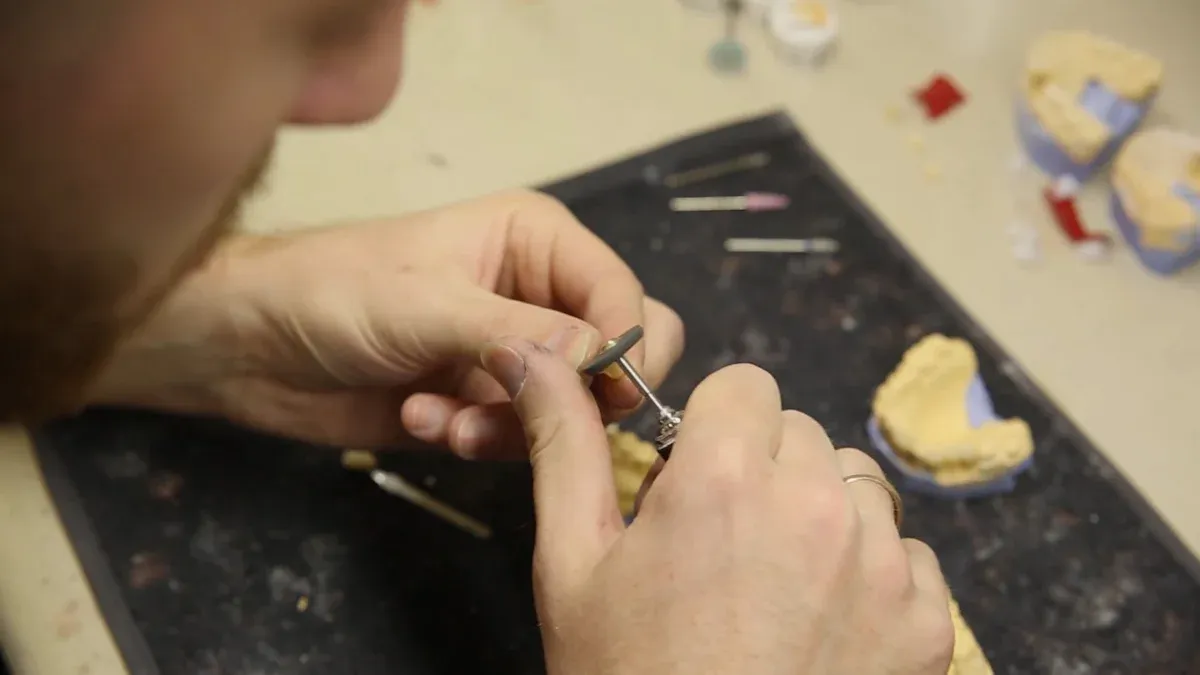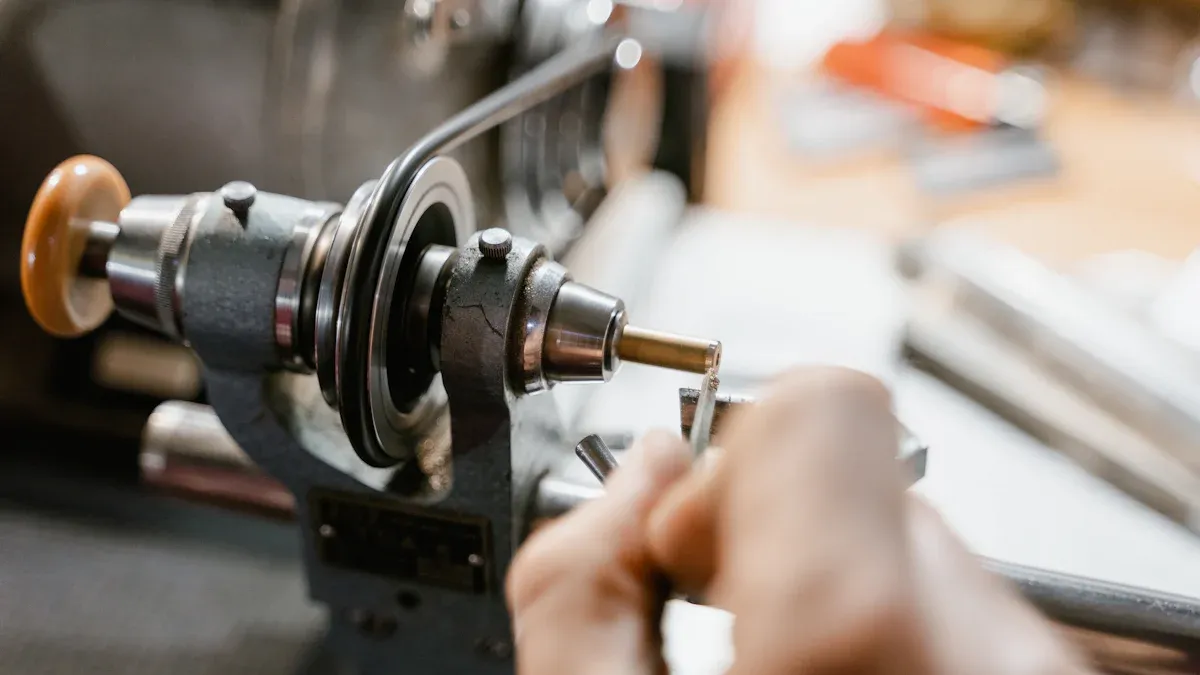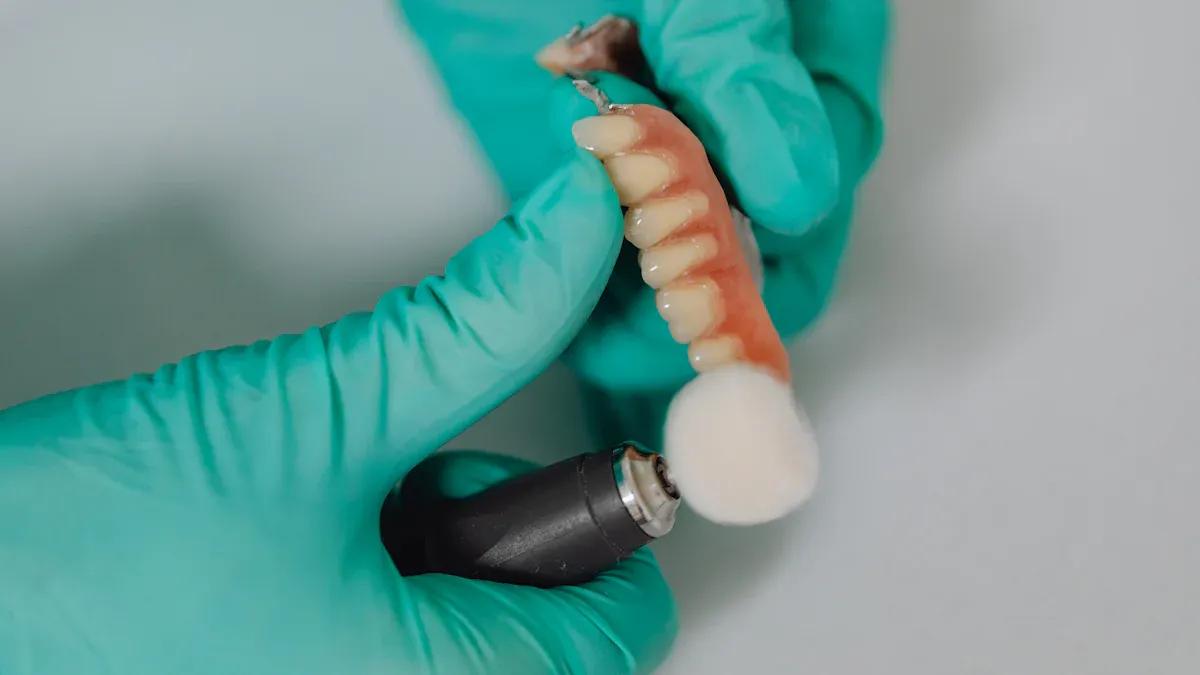
Injection mold polishing plays a vital role in creating high-gloss surfaces that enhance product aesthetics and functionality. A polished mold surface ensures a smooth mold surface with high reflectivity, giving products a high-quality appearance. Polishing influences surface parameters significantly. For instance:
Polishing not only improves surface quality but also ensures a suitable injection moulding surface finish, resulting in high-quality surface finishes. By following best practices for effective mold polishing, you can achieve a smooth spi surface finish and maintain the injection mould tool surface finish for optimal results.
Injection mold polishing is the process of refining the surface of a mold to achieve a smooth and glossy finish. This technique enhances the mold's surface quality, ensuring that the final product meets aesthetic and functional standards. Polishing removes imperfections, such as scratches or tool marks, that could affect the appearance or performance of molded parts.
A polished mold surface plays a critical role in injection molding. It ensures consistent product quality by reducing surface defects and improving the mold's durability. The injection moulding surface finish directly impacts the perceived value of the product, making it essential for industries that prioritize high-quality finishes.
Note: Textures can also be applied during polishing to improve grip quality or hide manufacturing flaws. This adds both aesthetic appeal and practical functionality to the final product.
Plastic injection mold polishing is widely used in industries that require precision and high-quality finishes. In the plastic injection molding sector, polishing ensures that products achieve the desired gloss and smoothness. This is particularly important for items like automotive components, consumer electronics, and medical devices, where appearance and functionality are critical.
Recent advancements in technology have transformed the plastic injection molding industry. Innovations in quality control and monitoring systems emphasize the importance of mold polishing techniques. These advancements ensure consistent production and minimize defects, making mold polishing a cornerstone of modern manufacturing practices.
Other industries also benefit from mold polishing. For example:
- Automotive Industry: Polished molds create sleek and durable components for vehicles.
- Medical Sector: High-quality finishes ensure safety and precision in medical devices.
- Consumer Goods: Polishing enhances the aesthetic appeal of products like packaging and household items.
Tip: Different materials require specific polishing standards. For instance, SPI injection moulding surface finish classifications (A-1, A-2, A-3) are used to achieve varying levels of gloss and reflectivity.
Here’s a quick reference table for material-specific benchmarks:
| Material | A-1 | A-2 | A-3 |
|---|---|---|---|
| ABS | Average | Average | Good |
| Polystyrene (PS) | Average | Average | Good |
| Nylon | Average | Average | Good |
| Polycarbonate (PC) | Average | Good | Excellent |
| Polyurethane (TPU) | Not recommended | Not recommended | Not recommended |
| Acrylic | Excellent | Excellent | Excellent |
Polishing standards like SPI A classifications are essential for achieving glossy finishes in high-polish parts. Semi-glossy finishes (SPI B standards) are better suited for components where appearance matters but high reflectivity is not required.
The growing demand for polished molds reflects the industry's focus on precision, miniaturization, and efficiency. As smart factory technologies continue to evolve, mold polishing remains a vital process for improving mold performance and ensuring high-quality production.
Polishing molds enhances the surface finish, which directly impacts the visual appeal of molded products. When you polish a mold, you eliminate imperfections like scratches or pits that could transfer to the final product. This ensures a smooth and glossy appearance, especially for high-gloss applications. For example, automotive parts and consumer electronics often rely on polished molds to achieve clarity and a professional look.
Did you know? The quality of the mold's surface determines the aesthetic value of the final product. A poorly polished mold can result in visible defects, reducing the product's appeal and marketability.
Proper mold polishing minimizes surface defects, ensuring consistent quality in every production cycle. By addressing issues like tool marks or uneven textures, you can improve the surface quality of the mold. This not only enhances the product's appearance but also prevents functional issues caused by imperfections.
Industry reports highlight that polished molds produce better-quality parts with fewer defects. For instance:
- Polished molds yield smoother finishes, which are crucial for customer satisfaction.
- The color of the plastic can influence how noticeable imperfections are, with darker colors requiring higher surface quality.
When you prioritize polishing, you ensure that your molds meet the highest standards of quality and performance.
Polishing molds correctly extends their lifespan and boosts their performance. Starting with a surface roughness of Ra/Rz = 0.5/5 µm is recommended to avoid common mistakes that could damage the mold. Over-polishing or using the wrong tools can reduce the mold's durability, leading to frequent repairs or replacements.
By investing in effective polishing practices, you not only improve the mold's longevity but also reduce maintenance costs. This makes mold polishing a cost-effective solution for long-term manufacturing success.

Mechanical polishing is one of the most common mold polishing techniques. It involves using abrasive tools or materials to physically smooth the mold's surface. This method is ideal for removing scratches, tool marks, or other imperfections. You can achieve a surface roughness (Ra) between 0.2 and 0.5 µm, making it suitable for applications where a moderate surface finish is acceptable.
Mechanical polishing works well for molds used in the automotive and medical sectors. For example, it is often used to polish molds for car interior components or medical device casings. However, this method requires precision to avoid over-polishing, which can damage the mold.
Tip: Use fine-grit abrasives and polish in a consistent direction to achieve a uniform finish.
Chemical polishing uses chemical solutions to dissolve surface irregularities and create a smooth, polished finish. This method is particularly effective for achieving high-gloss surfaces. It is often used for molds that require a mirror-like finish, such as those for optical lenses or high-end consumer electronics.
The process involves immersing the mold in a chemical bath containing specific compounds like triethylamine and silica. These chemicals react with the mold's surface, removing imperfections and enhancing its gloss. Studies have shown that chemical polishing can reduce surface roughness by up to 57.14%, making it one of the most efficient types of mold polishing methods.
Note: Always follow safety guidelines when handling chemical solutions to protect yourself and the mold.
Ultrasonic polishing is a modern technique that uses high-frequency vibrations to polish the mold's surface. This method is highly effective for intricate molds with complex geometries. It can achieve a surface roughness as low as 3 nm, making it ideal for precision applications like dental molds or aerospace components.
The process involves using an ultrasonic tool with a polishing fluid containing materials like alumina or potassium hydrogen phthalate. This combination ensures a high material removal rate of up to 25.96 nm/min while maintaining the mold's integrity.
Did you know? Ultrasonic polishing is particularly useful for molds made of hard materials like silicon carbide, as it minimizes the risk of damage.
Each of these polishing techniques offers unique advantages. By selecting the right method, you can ensure your mold achieves the desired surface finish and performance.
Abrasive polishing is a versatile technique that uses abrasive materials to refine the surface of molds. This method is highly effective for achieving a smooth surface finish and is widely used in injection mold polishing. You can rely on abrasive polishing to remove imperfections like scratches, pits, or tool marks, ensuring a flawless mold surface.
The process involves using abrasive compounds or tools, such as sandpaper, polishing stones, or diamond paste. These abrasives come in different grit sizes, allowing you to control the level of refinement. For example, coarse abrasives are ideal for initial polishing, while finer grits help achieve a high-gloss finish. This flexibility makes abrasive polishing suitable for molds used in industries like automotive, consumer goods, and medical devices.
Tip: Always start with a lower grit and gradually move to finer abrasives. This approach prevents over-polishing and ensures a consistent surface finish.
Abrasive polishing offers several advantages. It allows you to work on molds made of various materials, including steel and aluminum. The method also provides excellent control over the polishing process, enabling you to achieve precise results. However, it requires patience and attention to detail. Rushing through the process or applying uneven pressure can lead to inconsistent finishes or damage to the mold.
To get the best results, you should use high-quality abrasives and follow a systematic approach. Clean the mold thoroughly before starting, and inspect the surface regularly during polishing. These steps help you maintain the integrity of the mold and achieve the desired finish.
Did you know? Abrasive polishing is often combined with other techniques, such as mechanical or ultrasonic polishing, to enhance the overall quality of the mold.
By mastering abrasive polishing methods, you can ensure your molds deliver high-quality products with a professional appearance.
Choosing the correct tools and materials is the foundation of effective mold polishing. The tools you select should match the type of mold material and the desired surface finish. For instance, diamond paste works well for achieving a high-gloss finish, while polishing stones are better suited for removing deeper imperfections.
When working with harder materials like steel, you should use abrasives with higher grit levels to avoid damaging the mold. For softer materials, such as aluminum, opt for gentler abrasives to maintain the mold's integrity. Additionally, using lubricants during polishing reduces friction and prevents overheating, which can compromise the mold's surface.
Tip: Always keep your tools clean and free from debris. Contaminants can scratch the mold surface, undoing your polishing efforts.
Consistency is key when polishing plastic injection molds. Uneven surfaces can lead to defects in the final product, affecting both its appearance and functionality. To maintain a uniform surface finish, you should follow a systematic approach. Start with coarse abrasives to remove major imperfections, then gradually move to finer grits for a smoother finish.
Regular inspection during the polishing process ensures that the surface meets industry standards. Tools like profilometers help measure surface roughness, providing precise data on the uniformity of the finish. Visual inspections also play a crucial role in identifying inconsistencies that might not be captured by instruments.
The measurement of surface roughness is vital for determining the product's lifespan and performance. Industries like aerospace, automotive, and medical devices rely heavily on precise surface finish measurements to ensure reliability and functionality. By adopting these practices, you can achieve consistent results and enhance the quality of your molds.
Did you know? Consistent polishing practices not only improve the mold's performance but also reduce the likelihood of defects in the final product.
Polishing requires both safety and precision to achieve optimal results. Using the right protective gear, such as gloves and safety goggles, shields you from potential hazards like flying debris or chemical splashes. Proper ventilation is also essential, especially when working with chemical polishing agents.
Precision comes from maintaining control over your tools and techniques. Apply consistent pressure during polishing to avoid over-polishing, which can damage the mold. Work in a well-lit environment to spot imperfections easily and make necessary adjustments.
Tip: Always secure the mold firmly before polishing. A stable mold reduces the risk of accidents and ensures a more precise finish.
By prioritizing safety and precision, you not only protect yourself but also enhance the quality of your work. These practices ensure that your molds deliver high-quality products with a professional appearance.

Over-polishing is a common challenge in mold polishing. It can damage the mold surface and reduce its lifespan. You can avoid this issue by controlling the pressure and time spent on polishing. For example, adjust the polishing pressure based on the mold's hardness and the grade of the diamond paste. This prevents excessive force that could harm the mold.
Using the right technique also helps. Rotary polishing with small circles ensures balanced and uniform grinding. Gradually extend to larger circles for a smooth transition. Always hold the tool flat and apply even force. This prevents uneven undercuts and maintains the mold's integrity.
Over-polishing often occurs when you rush the process or use improper tools. To avoid this, inspect the mold regularly during polishing. Look for signs of over-polishing, such as uneven surfaces or loss of detail. By taking these steps, you can protect the mold and achieve a high-quality finish.
Tip: Always match the polishing method to the mold material. This ensures optimal results and reduces the risk of over-polishing.
Achieving a uniform surface finish is essential for injection mold polishing. Uneven surfaces can lead to defects in the final product. To ensure consistency, start with coarse abrasives to remove major imperfections. Gradually switch to finer grits for a smoother finish.
Using the correct tools and techniques is crucial. For instance, rotary polishing with small circles creates an even surface. Extend to larger circles only after achieving a balanced base. This method ensures uniformity across the mold.
Regular inspections during polishing help maintain consistency. Use tools like profilometers to measure surface roughness. These tools provide precise data, allowing you to make adjustments as needed. Visual inspections are also helpful for spotting inconsistencies.
Did you know? A uniform surface finish not only improves the mold's performance but also enhances the gloss of the final product.
By following these strategies, you can achieve a consistent finish and produce high-quality molds. This ensures that your products meet both aesthetic and functional standards.
Surface roughness inspection plays a vital role in ensuring the success of injection mold polishing. It helps you maintain the desired gloss and finish, which directly impacts the quality of the final product. By inspecting surface roughness, you can identify imperfections early and make necessary adjustments to achieve consistent results.
Studies show that mold surface roughness significantly affects thermal boundary conditions during micro-injection molding. This impacts heat transfer and polymer flow behavior, especially in thin-wall micro parts. For example, higher roughness in thin cavities improves polymer filling, ensuring better performance. Proper roughness checks also help optimize the mold's ability to fill cavities effectively, especially in micro-scale applications.
To ensure reliable quality control, you can rely on various methods and standards. These include in-process assessments, inductance measurement, and ultrasound techniques. Standards like ISO 25178 and ISO 4287 provide guidelines for evaluating surface texture parameters, ensuring consistency across production.
| Method/Standard | Description |
|---|---|
| In-process assessments | Real-time monitoring of surface finish parameters during machining. |
| Inductance measurement | Effective method for assessing surface roughness. |
| Machine-based systems | Automated systems offering consistent roughness measurements. |
| Ultrasound measurement | Non-destructive method for evaluating surface texture. |
| ISO 25178 | International standard for surface texture parameters. |
| ISO 4287 | Standard for profile method surface texture parameters. |
To maintain quality control in mold polishing, you need the right tools and techniques. Profilometers are essential for measuring surface roughness accurately. These devices provide precise data, helping you identify inconsistencies and make necessary corrections. Machine-based systems also offer automated solutions for consistent measurements, reducing the risk of human error.
Standards like ISO 25178 and ASME B46.1 guide you in evaluating surface texture parameters. These standards ensure that your molds meet industry requirements for gloss and finish. Non-destructive methods, such as ultrasound measurement, allow you to inspect molds without causing damage.
Here are some key standards to consider:
- ISO 25178 – Geometrical product specifications for surface texture parameters.
- ISO 4287 – Profile method for surface texture parameters.
- ISO 13565 – Profile method for surfaces with stratified functional properties.
- ASME B46.1 – Surface texture standards.
By using these tools and adhering to established standards, you can ensure consistent quality in your molds. This not only improves the performance of your molds but also enhances the overall quality of your products.
Mastering injection mold polishing is essential for producing high-quality molds and achieving a flawless gloss on finished products. By applying expert techniques, you can enhance surface finishes, reduce defects, and extend mold longevity. Quality control plays a pivotal role in this process. Rigorous testing and inspection ensure that every part meets precise specifications, minimizing the risk of inconsistencies or defects.
Polishing is a skill that requires practice and precision. It involves more than just surface refinement; it demands a systematic approach to achieve consistent results. By combining these techniques with robust quality control measures, you can optimize your molds for superior performance and aesthetics. Start implementing these tips today to elevate your manufacturing outcomes.
You should use light, consistent pressure and inspect the surface frequently. Over-polishing often happens when you apply too much force or polish for too long. Use tools like profilometers to monitor surface roughness and stop polishing once the desired finish is achieved.
Tip: Always match the polishing tool to the mold material for better control.
Select the technique based on the mold material and the desired finish. For example, use chemical polishing for high-gloss surfaces or ultrasonic polishing for intricate designs. Mechanical polishing works well for general applications.
Note: Test a small area first to ensure the technique suits your mold.
Yes, polishing reduces surface imperfections that cause wear and tear. A smooth surface minimizes friction during production, extending the mold's lifespan. Proper polishing also prevents defects that could weaken the mold over time.
Did you know? Polished molds require less maintenance, saving you time and money.
You need abrasives like diamond paste, polishing stones, and sandpaper. Profilometers help measure surface roughness, while lubricants reduce friction. Ultrasonic tools are useful for complex molds.
Tip: Keep your tools clean to avoid contaminating the mold surface.
Wear gloves, safety goggles, and a mask to protect yourself from debris and chemicals. Work in a well-ventilated area and secure the mold to prevent accidents. Follow the manufacturer's guidelines for all tools and materials.
Reminder: Never skip safety checks, even for small polishing tasks.